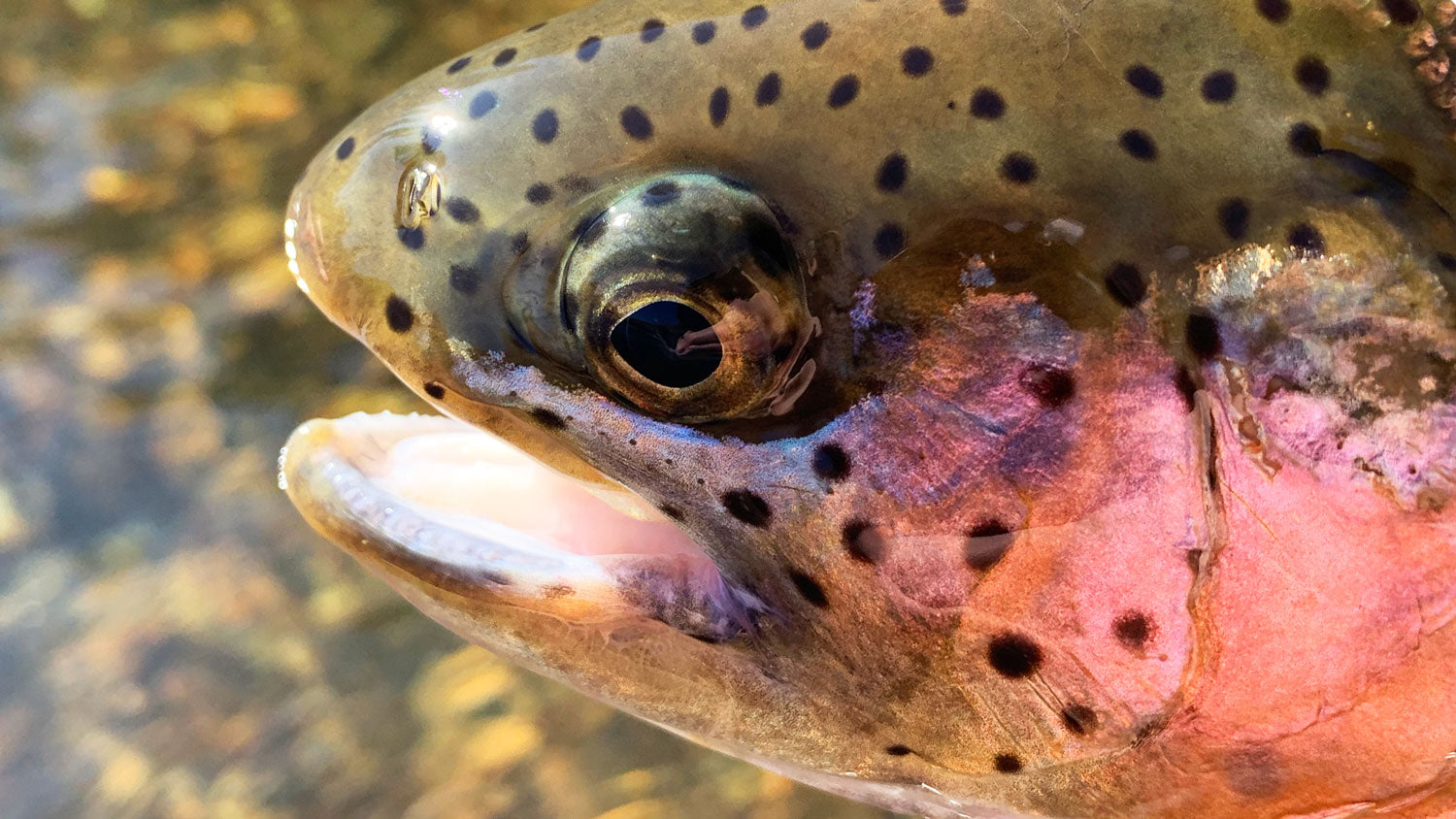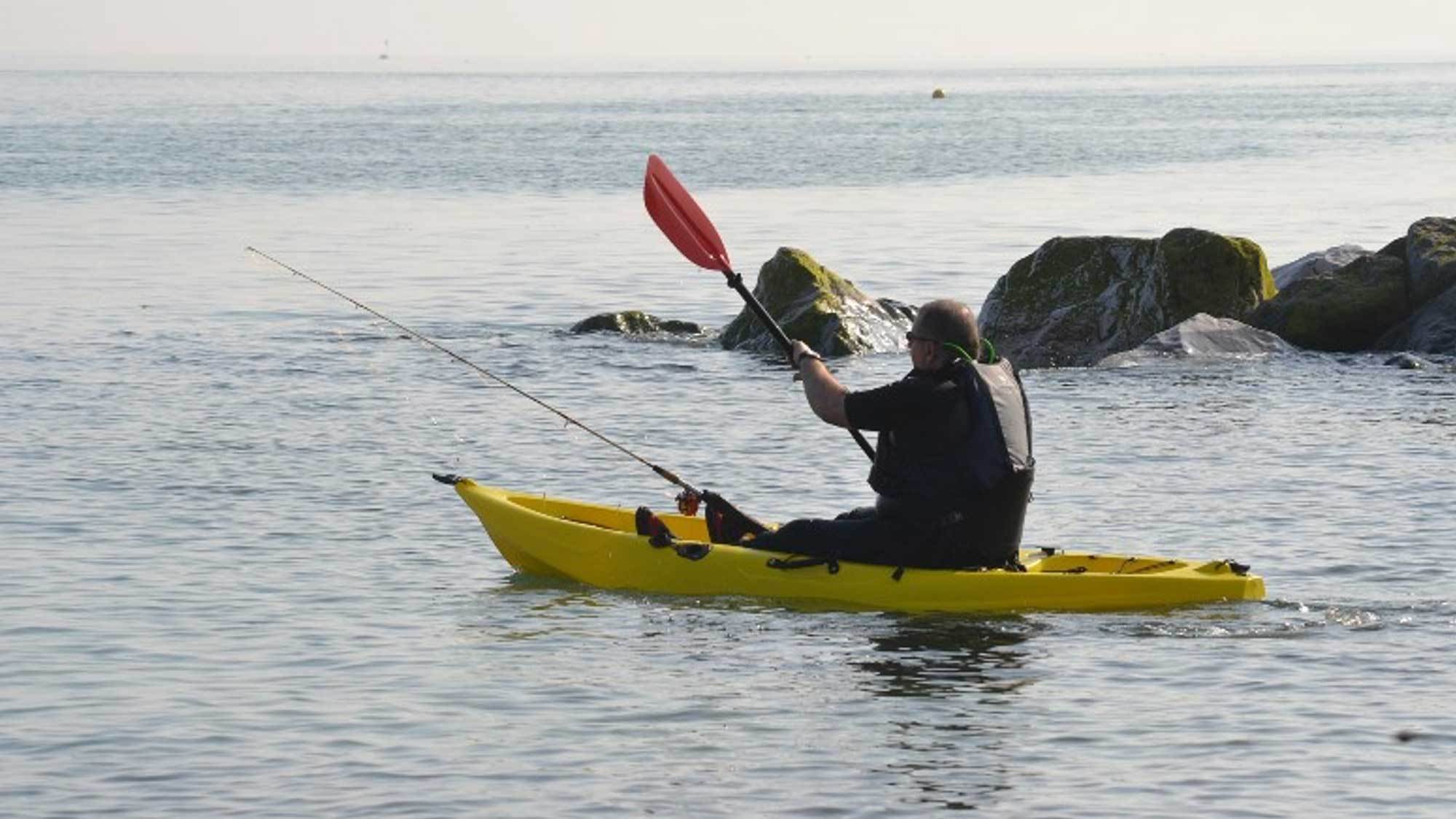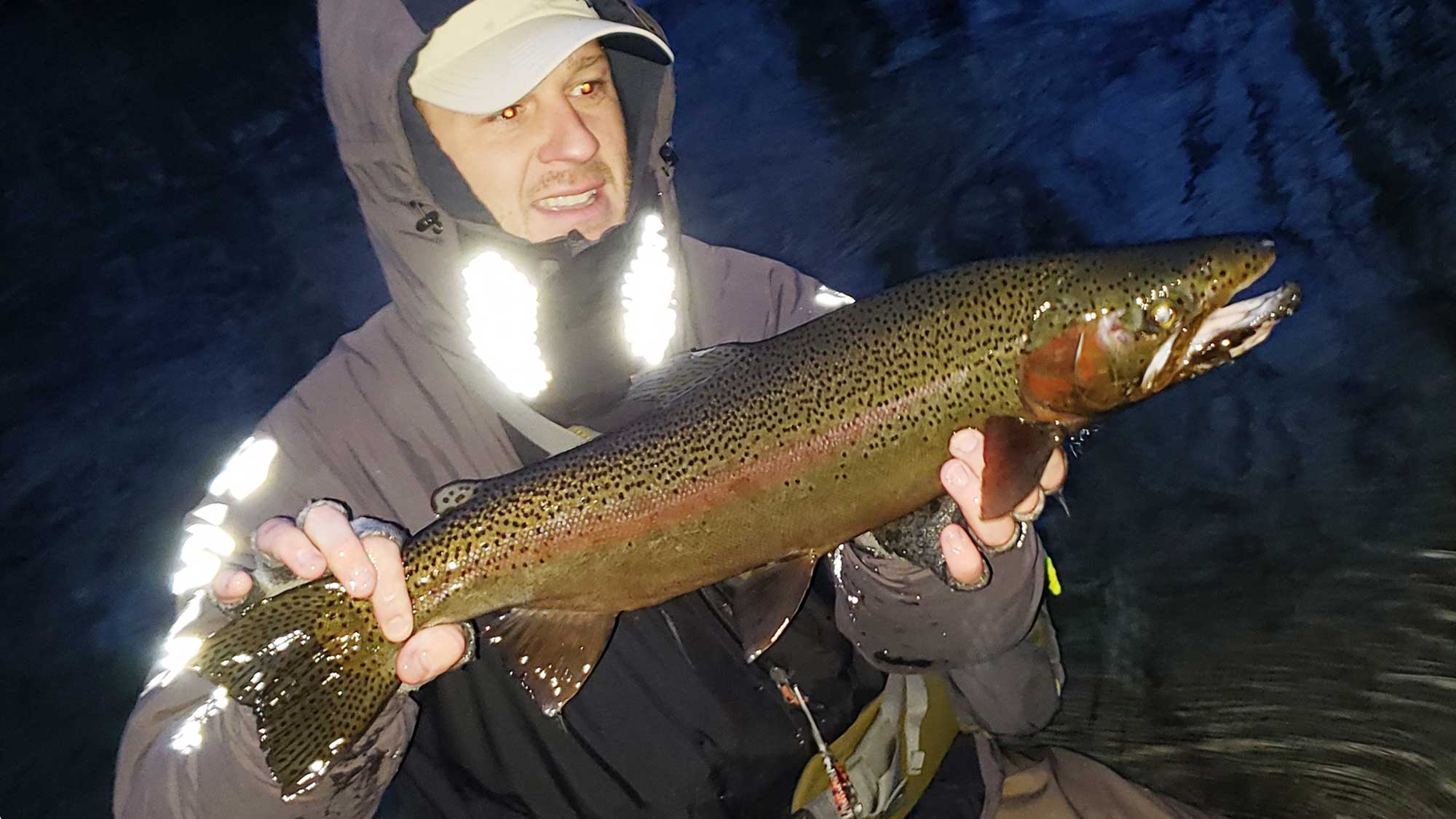
20 Fly Fishing Tips for Rainbow Trout
Firstly, you need to forget the myth that fly fishing for rainbow trout is easy. Nothing is guaranteed when you head out onto the water, especially with trout. While spinners and lures are more straightforward than nymphs and dry flies, fly fishing is a skillful art form. It might seem impossible to get into, but it is not as hard as you think. And when you get your first hit from a rainbow your life will be forever changed.
Here are twenty more fly fishing tips you should keep in mind the next time you cast for rainbow trout.
#1: Match the Surroundings While Fly Fishing for Rainbow Trout
As a person who wants to fly fish for trout, you have to realize that your clothing plays a role in your ability to catch. This is because you’re very close to the bank or in the water with the fish for the most part. As a result, you’re conspicuous and easy to spot unless you blend into the environment. Plus, if you’re fishing a spot that’s popular with anglers, the rainbows won’t bite anything you present on the water. They’re sneaky, so you have to be sneaky, too.
The best tip is to dress in neutral colors that match the surrounding. If it is a bright blue sky out, wear lighter colors. If you are fishing in a canyon wear neutral tones to match the canyon walls. Alternatively, you can wear camouflage or khaki combat gear to help you blend into the environment more successfully.
Remember that if you’re stalking fish, you must be extra quiet and move carefully so that you don’t alert them of your presence.

#2: Practice Casting on the Bank before Fly Fishing for Rainbow Trout
In many instances, you only get one shot to nail your cast. If you get it wrong, you could have to pack up your equipment and go searching for another location. By all means, embrace the challenge, but give yourself the best opportunity to succeed, too. You can do this by setting up your rod and fly and dry casting on the bank.
Aim for a spot in front of you and try and hit it with precision and accuracy. Make sure it’s a similar distance to the actual place on the water so that the process is consistent. Once you’re happy with your casting, you can go live and (hopefully) land the fly in the perfect place to optimize a catch.
#3: Let A Buddy Tag Along when Fly Fishing for Rainbow Trout
Fly fishing is a social sport, one that you can enjoy with your friends. However, there’s more to it than not being alone - it’s an excellent way to share knowledge. A single angler can’t cover every volume of H2O in the surrounding area because there is too much of it for one person.
However, the chances are that your buddies have fished the location before, or they have fished similar waterways, and understand what works and what doesn’t. By picking their brains and following their lead, you choose a type of fly and a color variation that gets the fish biting. For example, steamers might be more effective than nymphs, or dry flies could be the meal of choice for trout.
When you’re angling with a partner, you can use different techniques to figure out which one works the best and enhance your chances of landing a rainbow.

#4: Watch the Water when Fly Fishing for Rainbow Trout
Are you and your fishing friend not experiencing the results you imagined at the beginning of the day? If so, there’s a basic solution - watch the water. Although working your way through a systematic fly selection is an excellent tip, to get you on the right track you will also need to analyze the feeding habits of the trout.
Once you know what they are eating on the day, you can switch up your flies to match the ones on the river. As long as you present them naturally, you should get a bite. To do this requires patience to arrive and review the water before diving into the fly fishing.
#5: Carry The Appropriate Flies when Fly Fishing for Rainbow Trout
Having the ability to change flies to suit the environment is a luxury if your box isn’t packed with alternatives, from dry flies to streamers and nymphs. The last thing you want is to arrive at the swim for a full day session only to recognize the hatch the trout are feasting on isn’t in your fly fishing kit. Some people may enjoy the challenge, yet mostly, it’s a frustrating way to spend a day.
What makes rainbow trout popular targets is that they respond well to a variety of flies. However, that's also problematic because there are more flies for them to choose from for their dinner. As a rule, you will want to follow a seasonal hatch chart like below and have an assortment that can mimic these patterns.
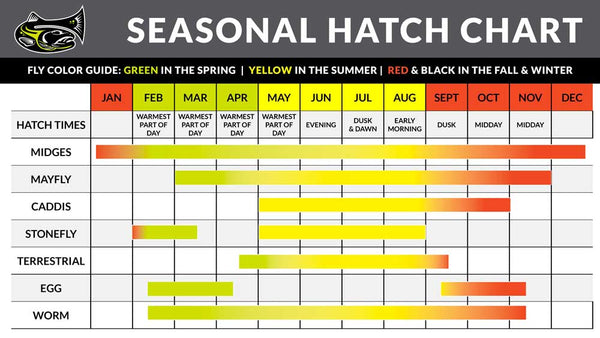
#6: Change the Presentation When Fly Fishing for Rainbow Trout
Considering that fly fishing is about experimenting and trying new things, it's easy to get into casting and changing patterns when one pattern doesn't provide results. If you experience this phenomenon, the best thing to do is to stop.
The results show that it's not the pattern that's the problem, especially if you've tied one that the rainbows are feeding on regularly. Your presentation is the issue, and it requires fixing before you can convince the fish to bite.
#7: Go Under the Surface when Fly Fishing for Rainbow Trout
A common mistake is to present flies in line with your imagination. In most anglers' minds, there's nothing more satisfying than watching a rainbow trout appear out of the murk to swallow a fly whole. It's a fantastic feeling, yet it's not how trout usually feed.
Rainbows typically hunt beneath the surface, picking up leftovers that have fallen into the water or lava that’s vulnerable. With this in mind, it’s better to untie the dry fly and switch to a tactic that works under the surface. Nymphs, wet flies, and streamers are the best friends a fisherman or woman can wish for while fly fishing.
This is because they let you target the fish and present the pattern to them, rather than waiting for the fish to come to you. Doing the latter requires patience, whereas the former allows you to be proactive in improving your chances of landing a fish. Carrying the same nymphs and streamers in varying weights is a neat trick as it lets you fish deeper without changing the color pattern.
#8: When Fly Fishing for Rainbow Trout, Plan Breaks Around the Trout
Taking a break helps you to stay fresh and evaluate the day's fishing up until that point. Your hunger isn't going to go away until you've had your lunch and satiated your appetite. A huge mistake is to put down your rod when the trout are about to start feeding with extra confidence.
If you need to take a break, the smart move is to plan your day in advance. That way, you can keep things exciting without missing out on the best opportunities to land a beautiful rainbow trout.
Check your local hatch times to find the best times to be on the water. This will differ from location to location.

#9: Use Fluorocarbon Tippet When Fly Fishing for Rainbow Trout
Never assume that rainbow trout are stupid enough to eat anything that you put in front of their mouths. Like they notice the presence of a fly in the water, they also spot anything attached to the fly. As such, your setup can get in the way of a confident take from a big rainbow.
It’s not as if you can remove the leader, and you need the line to present the hook, so what are the options? A brilliant tactic is to swap out your monofilament spool for a fluorocarbon version. A property of fluorocarbon is that it is almost invisible once it hits the water, making it tough for the trout to recognize the difference between a real fly and your artificial bait.
Many anglers report significant jumps in takes and bites by merely switching the line to fluorocarbon and appeasing the trout's sensitive and curious nature.

#10: Fish with Extra Precaution During Rainbow Spawning Season
Fly fishing for rainbow trout during spawning season is a bust for most anglers as the fish aren’t interested. Their instincts force them to focus on more pressing matters, with little time for feeding.
Some anglers do enjoy fishing during spawning season as the trout, particularly the females, are bigger. However, on average, the trout aren't interested in flies and bait, which makes the fishing a lot slower and more leisurely. Here are the signs it's spawning season, or that the fish are about to spawn:
- It's early to late spring - rainbows spawn from the end of winter to the start of summer in the northern hemisphere.
- When the water temperature is between 42 to 44 °F - eggs don't survive in cold water.
- The river is cloudy - females release thousands of eggs at a single time.
- The rainbows are over one year old - this is when they reach sexual maturity.
During this time, it is great to fly fish for Brown Trout as they are aggressively going after Rainbow spawning eggs.

#11: Try A Indicator When Fly Fishing for Rainbow Trout
Indicators aren’t synonymous with fly fishing because there are plenty of ways to tell if you get a strike.
Still, if you're struggling to time the take correctly, a float will give you a better indication of when to lift the rod. Anything that provides you with extra confidence is worth trying out, as missing a take is a simple way to improve your catch ratio.
Another excellent feature of a float is that it keeps the nymph or streamer off the bottom with the extra buoyancy. Rainbows are bottom feeders, yet they mainly take hatchlings from the middle of the water column or off the top of the water as this is how the insects naturally behave.

#12: Retrieve Properly When Streamer Fly Fishing for Rainbow Trout
The most frustrating scenario is when a fish follows your streamer to the water's edge, and tails off at the last second. The temptation is to slow down to give the trout more time to strike, but this won't play into your hands.
If anything, you should speed up your retrieve and force the rainbow to make a decision. You must encourage the fish to act on instinct as this is when their habits will kick in and take over. Slowing down means they have more time to examine and the bait, which puts them in two minds. Often, they'll abort and go on the hunt for a food source that's less confusing.
Keep in mind that the conditions play a part in the speed of your retrieve. For instance, in colder water, you should retrieve in the fly steadily as the fish will want to conserve energy to stay warm.
#13: Target Nooks And Crannies When Fly Fishing for Rainbow Trout
Rainbow trout aren’t the only predators in the river or lake. Depending on the location, there could be everything from herons and kingfishers to otters. Watch out for bears, too, as they’ll eat any fish they can catch.
This is important because it means that rainbows can't wait for an opportunity to arise. They require cover, only breaking it when they spot an insect or a small fish or crayfish to snap up. With that in mind, it might be smarter to target the breaks where there is plenty of vegetation.
By doing this, the trout can remain tucked up in weeds and submerged trees while hunting simultaneously.

#14: Play Them Aggressively When Fly Fishing for Rainbow Trout
It goes without saying, but you can’t let a rainbow trout dive for cover once it’s hooked. Of course, this is very likely if you’re targeting the opposite bank with your casts. The key is to strike firmly and play them aggressively from the outset as they are impossible to land when they are snagged. To avoid this try these things:
- Setting the hook quickly as possible
- Using the rod to create different angles - playing rainbows from the top and sides encourages them to swim in different directions.
- Attach robust line - if you know the snags exist, using a durable line is less likely to result in snaps.

#15: Utilize A Boat When Fly Fishing for Rainbow Trout
When the conditions are challenging, or the ideal spot is too far to cast to, you should use a boat to make the water as accessible as possible. Always take the proper safety equipment with you, even if you believe the water is shallow enough to stand up or swim in. A lifejacket is a necessity.
The next step is to format the boat to improve your chances of catching. To do this, you should consider a hard-bottom boat as it lets you stand up and observe the fish. Alternatively, you can rig your seat so that you’re higher in the chair and more upright, giving you a similar field of view.

#16: Be Active When Fly Fishing for Rainbow Trout
Staying active is something that anglers forget to do because it's easy to get lost in the battle between presenting and landing a big rainbow trout. When you do, you reduce your chances of catching lots of fish as the trout won't stay in a single spot. Like their prey, they move around to search for more bait.
You must follow them and put the fly in their field of vision. The trout will happily feast on authentic food sources. Being active is similar to changing your pattern or presenting the fly - you should do it at regular intervals if you're not getting many takes.
As a rule, thirty minutes in the same position is enough if you’re not catching or the bites.

#17: Remain Comfortable When Fly Fishing for Rainbow Trout
Feeling comfortable will encourage you to stay out for longer, boosting your chances of catching fish. Therefore, it’s critical to pack anything that’s going to allow you to stay in the water all day. The first thing to note is that you should pack layers as standing in the same spot gets cold, and if it heats up, you can remove an item.
If standing isn’t your thing, you can cast from a deck or camping chair. The latter is more comfortable due to the material, and it’s adjustable. On hot days, you’ll require a hat and sun lotion to prevent burns, and glasses to stop you from squinting.
A bivvy or tent can be useful regardless of the conditions as it provides shelter from the heat or the rain.
#18: Check the Weather Forecast before Fly Fishing for Rainbow Trout
Checking the weather forecast isn’t only so that you know what essentials to carry. It also notifies you how the trout will act. For example, when it’s raining, rainbows patrol the edge of the bank where the water is still deep, as this is where on-shore insects enter the river.
On the flip side, a heatwave is going to make fishing tricky. This is because the optimal temperature for trout is between 42 and 68°F. When the water is hotter than 68°F, the fish get distressed and concentrate more on keeping cool than feeding.
When the mercury hits 75 to 77°F, the rainbows will be undercover and deeper in the water as prolonged exposure to this type of temperature is fatal for fish.

#19: Strike Regularly when Fly Fishing for Rainbow Trout
Now that you're getting regular takes, you shouldn't be indecisive. For one thing, a trout might nibble at your bait without taking it in its mouth whole. For another, rainbows are subtle eaters, so you need to strike regularly to set the hook and boost your chances of a bite.
When you feel something on the line or your indicator stops or moves, you should raise the rod suddenly and confidently. Even if it wasn’t a bite, it’s better to strike firmly and often than missing an opportunity.
#20: Handle with Care when Fly Fishing for Rainbow Trout
You’ve had the perfect day and want to come back to the spot for more fun later in the week. To do that, you must follow the rules and regulations concerning all fish. Every state is different, so you should read up before casting into the water.
By following these regulations, the rainbow trout will prosper, meaning that the fishing will get better and better in the future!
The Best Fly Fishing Flies on the Market for Rainbow Trout
Yes, adapting your setup to the conditions is imperative; however, some flies seem to work whatever the season or temperature. Here is a selection for your information.
- Parachute Adams: The Parachute Adams fly is a dry fly that works effectively because it resembles many hatching insects across the US. This makes it an excellent pattern to turn to even when the conditions aren't perfect for dry flies, as the way it mimics insects is second to none.
- Jujubee Midge: The Jujubee Midge produces all year round because midges hatch in all seasons, whether the water temperature is freezing or boiling hot. With the assistance of the deep hues, this nymph is as close to a sure thing as in fly fishing.
- Muddler Minnow: A Muddler Minnow is deadly due to its versatility. Designed with natural hair, it has buoyancy and can be fished at all depths, while the striking colors mimic young minnows, encouraging rainbows to feast until their hearts are content.

Drifthook
If you need advice on anything from fishing equipment and accessories for beginners to experts from information on the latest trends, please don't hesitate to send us a chat, or email. We love fly fishing and want everyone else to love it too.
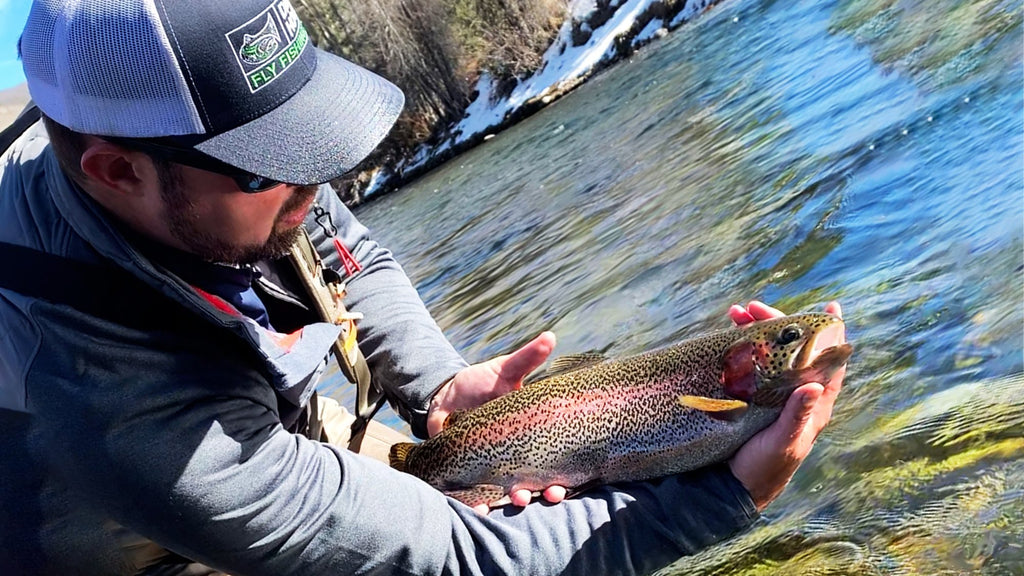
About the Author
Matthew Bernhardt, a third-generation Coloradan, grew up at the forefront of the state’s fly-fishing revolution, enjoying time on the water, side by side with experienced guides and lifelong anglers.
By combining his passion for fly-fishing with input from other experienced fly-fishers and guides and his fine arts degree from Colorado State University, Matthew spent five years carefully developing the Drifthook Fly Fishing System, built to help every angler catch more trout.
When he’s not spending time with his wonderful family, you’ll find him out on the water catching MONSTER trout, and he anxiously looks forward to the day when his kids are old enough to join him there.

